I also use it on squeaky door hinges in the house,
RC10B4.1 Factory Team Worlds Kit by Slotcarrod
Forum rules
This is a catch-all forum for any make and model produced from the year 2000 to present day.
This is a catch-all forum for any make and model produced from the year 2000 to present day.
- Orange
- Approved Member
- Posts: 890
- Joined: Fri Apr 24, 2009 12:42 pm
- Location: Chandler, AZ USA
- Been thanked: 1 time
Re: RC10B4.1 Factory Team Worlds Kit by Slotcarrod
It looks light brown... Not black. The best part is that if applied right, it won't infiltrate the diff. It goes on watery and then thickens up. I put it on top shaft and counter gear. It's made to not spin off rotating parts. Good stuff.
I also use it on squeaky door hinges in the house,
I also use it on squeaky door hinges in the house,
- slotcarrod
- Approved Member
- Posts: 4415
- Joined: Tue Nov 25, 2008 10:57 pm
- Location: Calgary Alberta Canada
- Has thanked: 1 time
- Been thanked: 45 times
Re: RC10B4.1 Factory Team Worlds Kit by Slotcarrod
Some other weight savings! Of interest is the standard plastic top plate is lighter than the carbon fiber one!  The arms are near the same weight, but the shock towers are much lighter in carbon!
The arms are near the same weight, but the shock towers are much lighter in carbon!
Top plates
Carbon
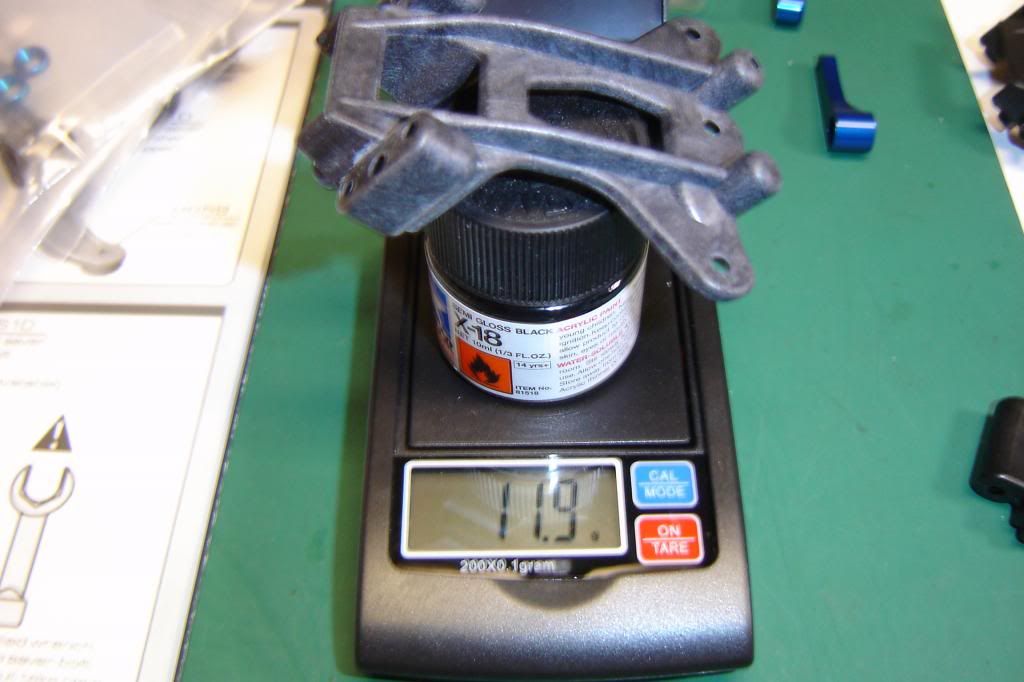
Stock
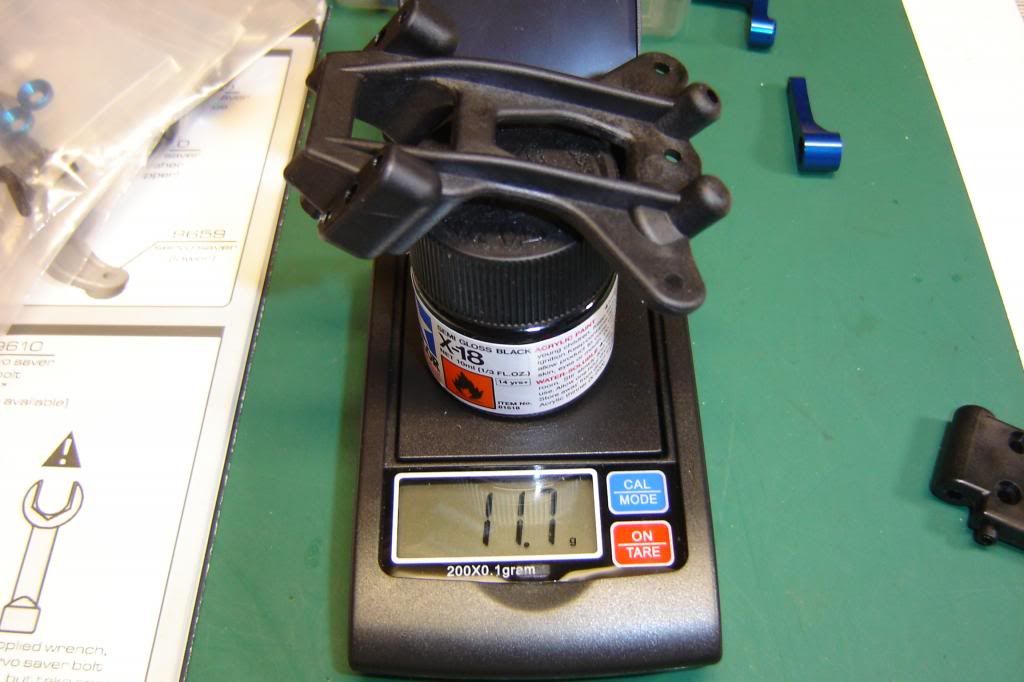
Arms
Carbon Fr

Stock Fr
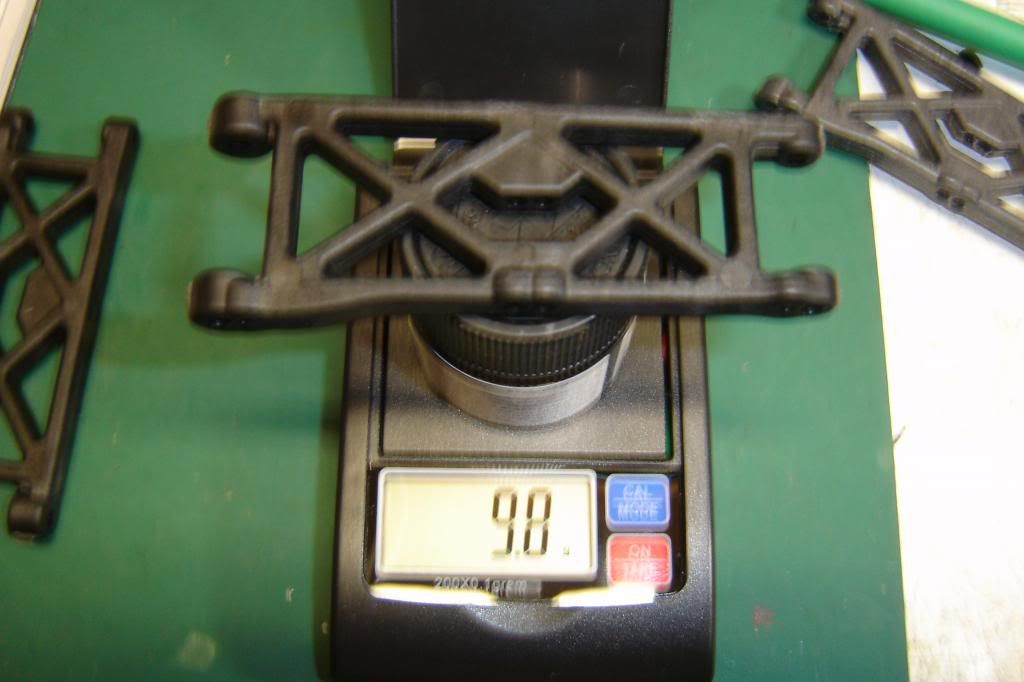
Carbon R
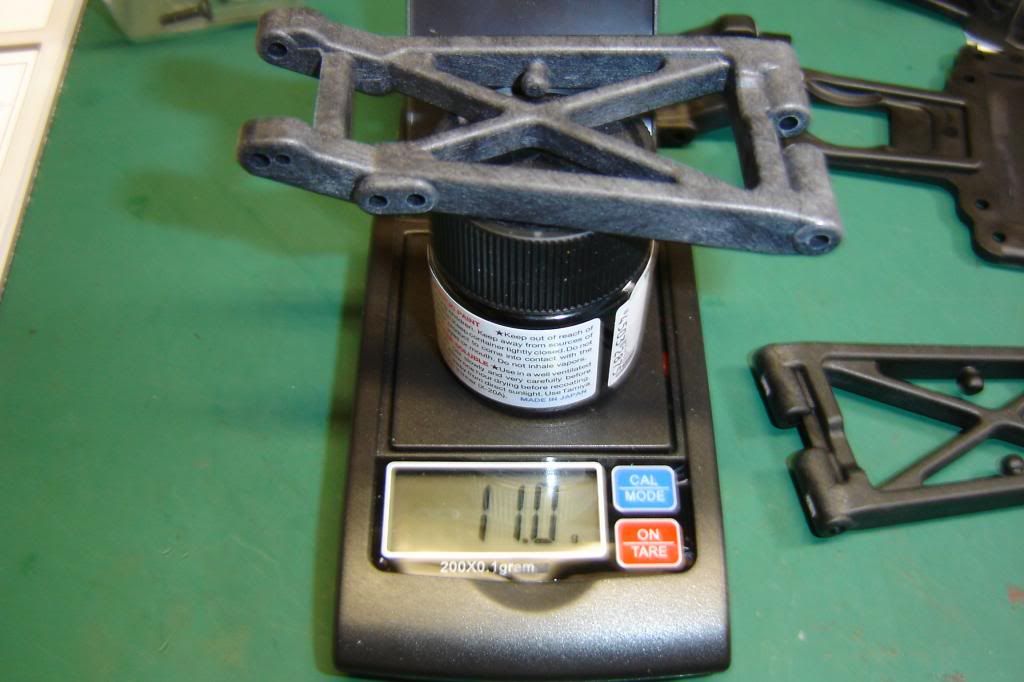
Stock R
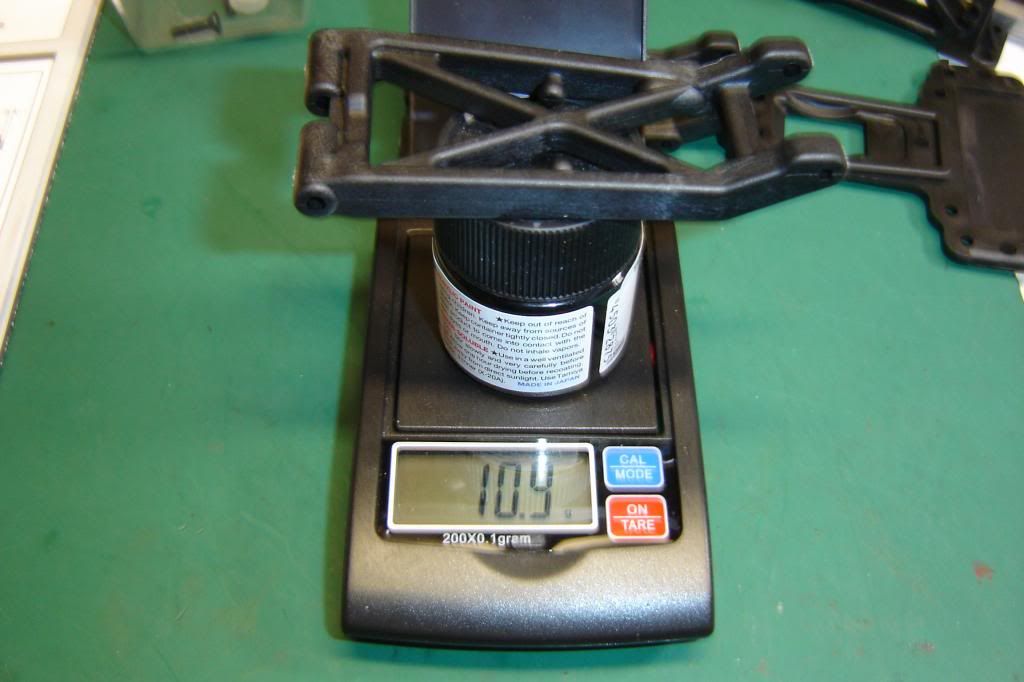
Top plates
Carbon

Stock

Arms
Carbon Fr

Stock Fr

Carbon R

Stock R

Rod Littau
Slotcarrod's Rumpus Room: http://www.rc10talk.com/viewtopic.php?f=77&t=16113
25 Years of the RC10: http://www.rc10talk.com/viewtopic.php?f=35&t=13059
Slotcarrod's Rumpus Room: http://www.rc10talk.com/viewtopic.php?f=77&t=16113
25 Years of the RC10: http://www.rc10talk.com/viewtopic.php?f=35&t=13059
- slotcarrod
- Approved Member
- Posts: 4415
- Joined: Tue Nov 25, 2008 10:57 pm
- Location: Calgary Alberta Canada
- Has thanked: 1 time
- Been thanked: 45 times
Re: RC10B4.1 Factory Team Worlds Kit by Slotcarrod
Now check out the towers!
Carbon Fr
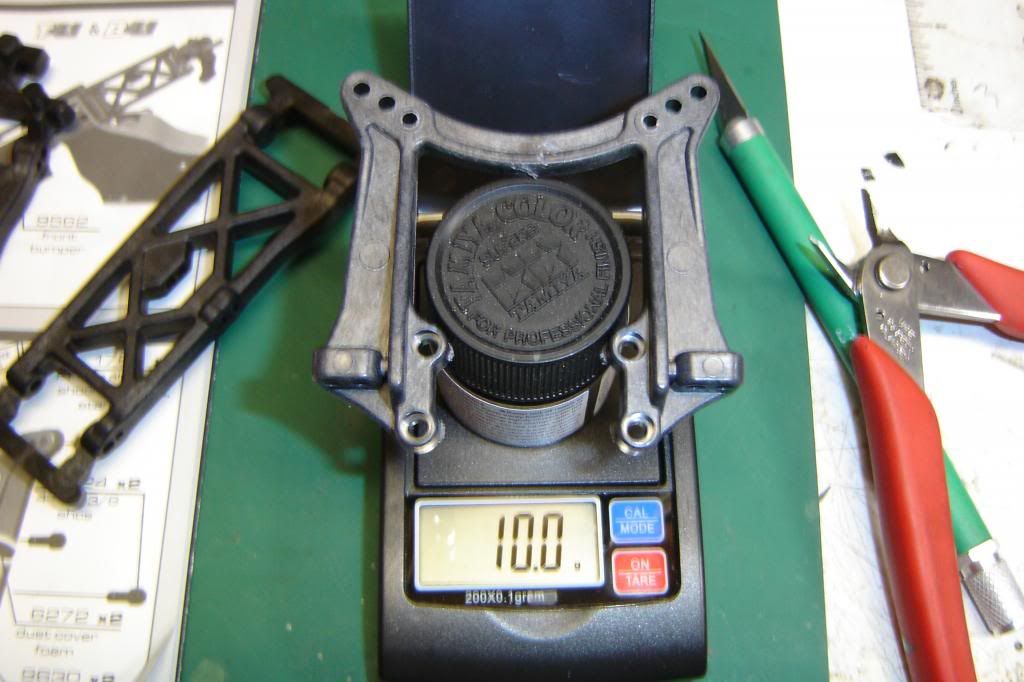
Stock Fr
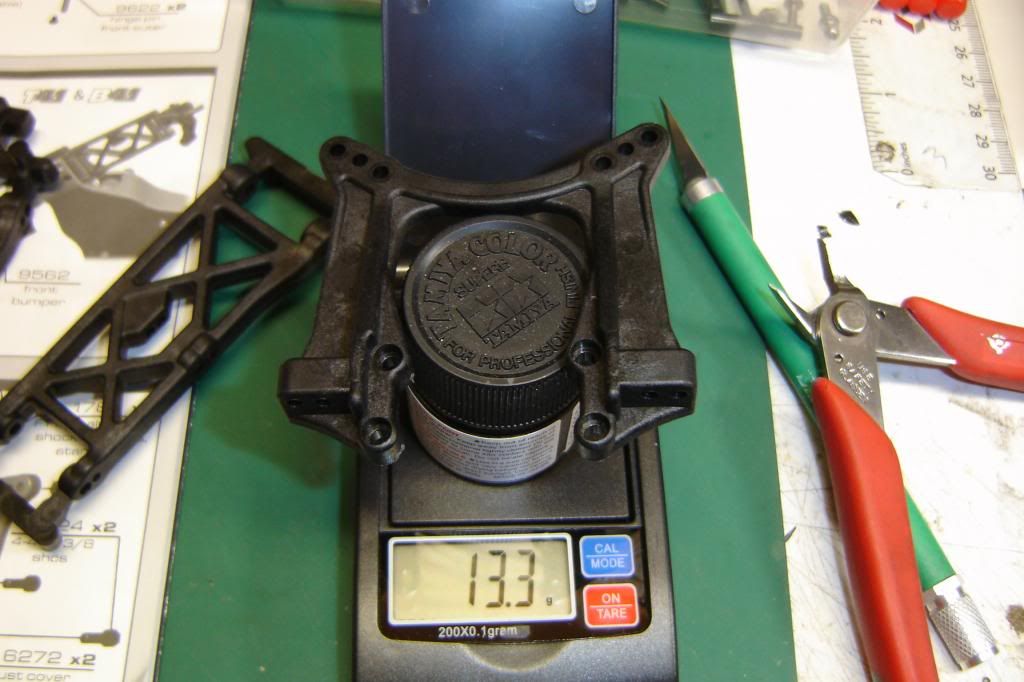
Carbon R
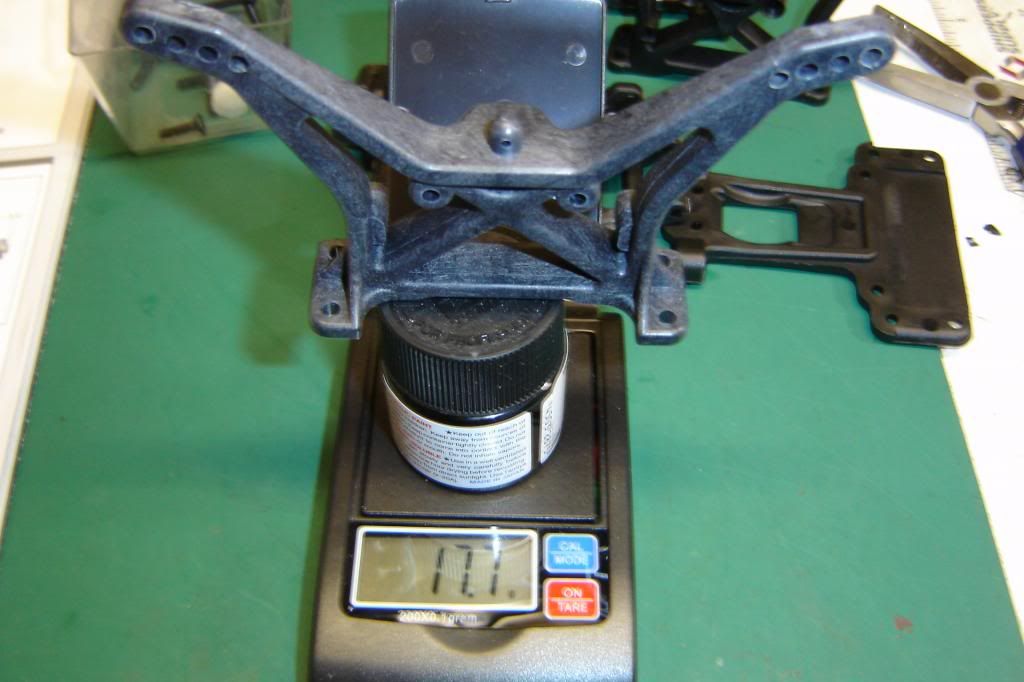
Stock R
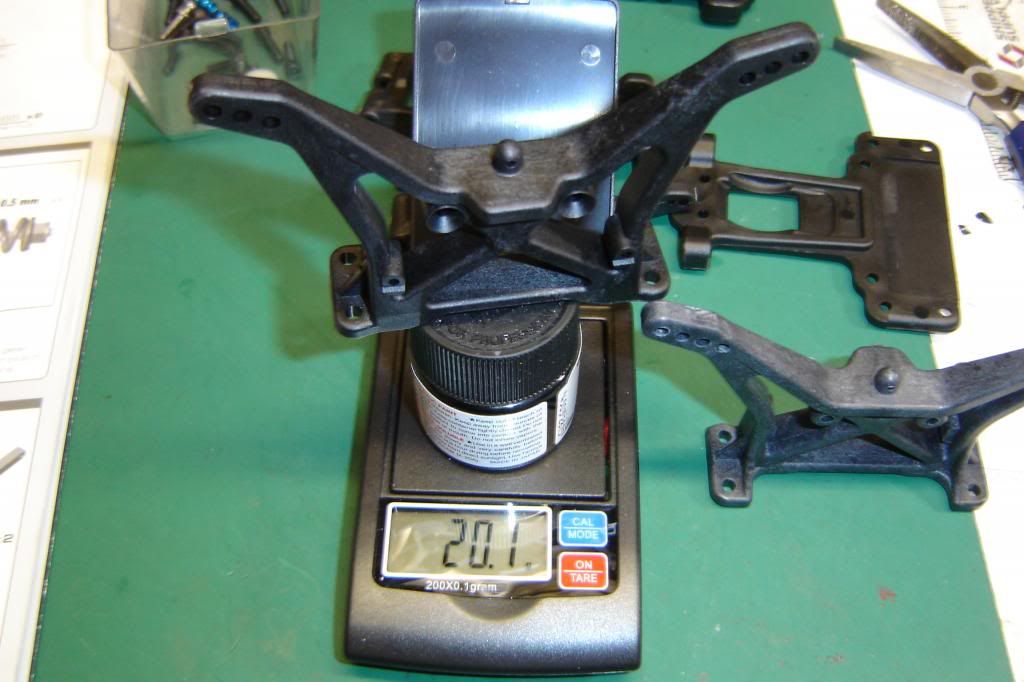
Carbon Fr

Stock Fr

Carbon R

Stock R

Rod Littau
Slotcarrod's Rumpus Room: http://www.rc10talk.com/viewtopic.php?f=77&t=16113
25 Years of the RC10: http://www.rc10talk.com/viewtopic.php?f=35&t=13059
Slotcarrod's Rumpus Room: http://www.rc10talk.com/viewtopic.php?f=77&t=16113
25 Years of the RC10: http://www.rc10talk.com/viewtopic.php?f=35&t=13059
- vintage AE
- Approved Member
- Posts: 3012
- Joined: Fri Nov 14, 2008 1:47 pm
- Location: Sunken Lake, Nova Scotia
- Has thanked: 29 times
- Been thanked: 36 times
- slotcarrod
- Approved Member
- Posts: 4415
- Joined: Tue Nov 25, 2008 10:57 pm
- Location: Calgary Alberta Canada
- Has thanked: 1 time
- Been thanked: 45 times
Re: RC10B4.1 Factory Team Worlds Kit by Slotcarrod
Need to update this build as I have finished it and not posted all the pics! 

So I'm still using the vented slipper disk on the back side of the slipper!

Steel front axles 5.1g
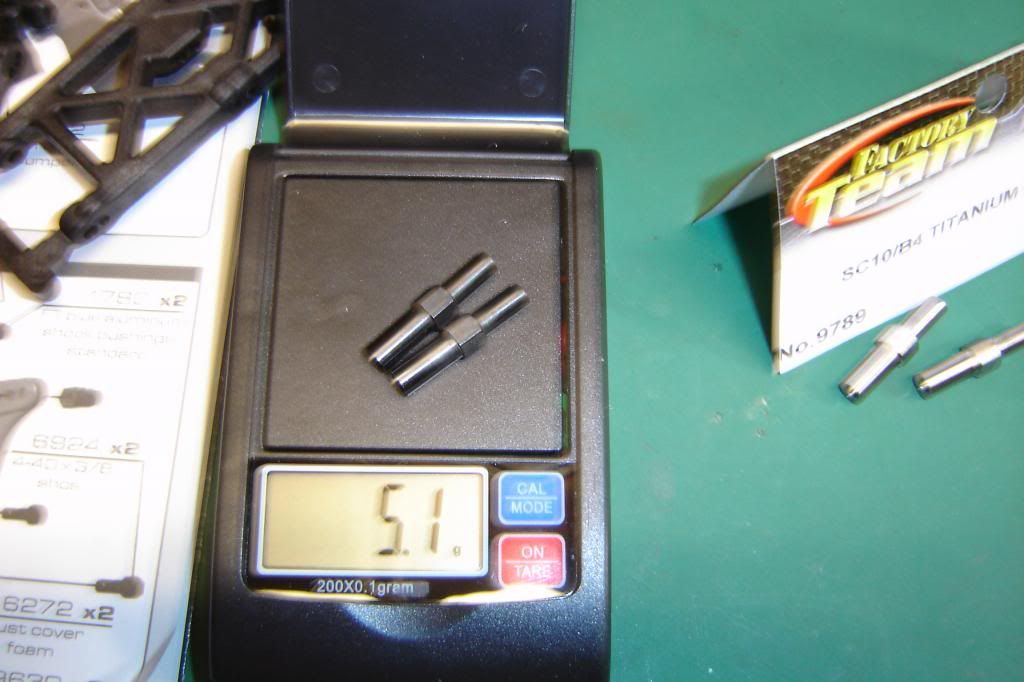
Titanium front axles 3.0g
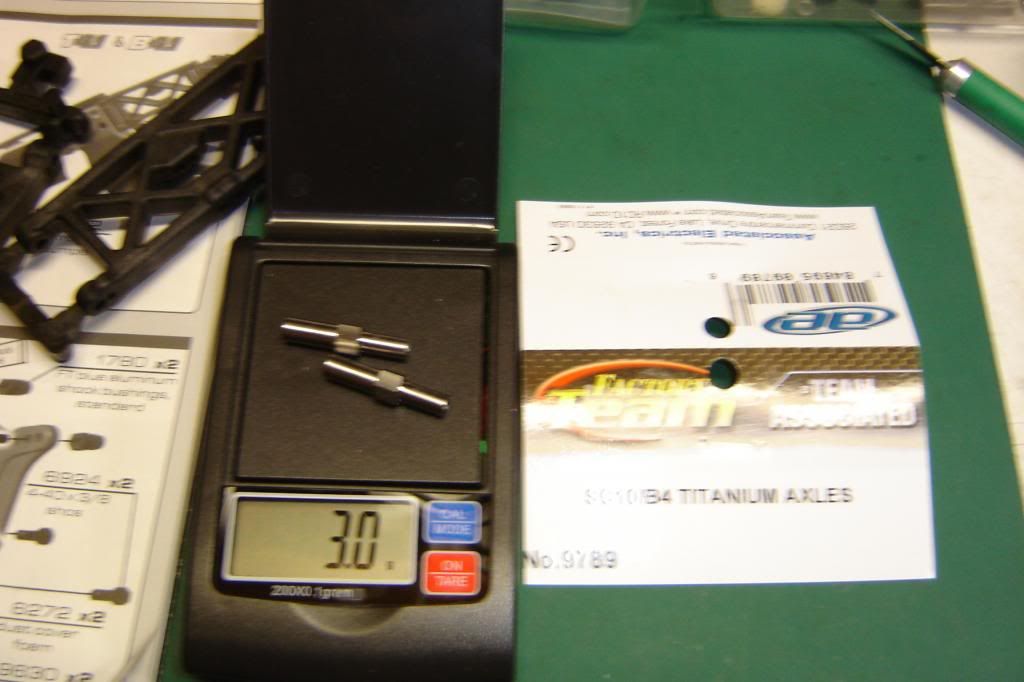
So I'm still using the vented slipper disk on the back side of the slipper!

Steel front axles 5.1g

Titanium front axles 3.0g

Rod Littau
Slotcarrod's Rumpus Room: http://www.rc10talk.com/viewtopic.php?f=77&t=16113
25 Years of the RC10: http://www.rc10talk.com/viewtopic.php?f=35&t=13059
Slotcarrod's Rumpus Room: http://www.rc10talk.com/viewtopic.php?f=77&t=16113
25 Years of the RC10: http://www.rc10talk.com/viewtopic.php?f=35&t=13059
- slotcarrod
- Approved Member
- Posts: 4415
- Joined: Tue Nov 25, 2008 10:57 pm
- Location: Calgary Alberta Canada
- Has thanked: 1 time
- Been thanked: 45 times
Re: RC10B4.1 Factory Team Worlds Kit by Slotcarrod
Stock steering bell crank assembly with bag is 7.8g
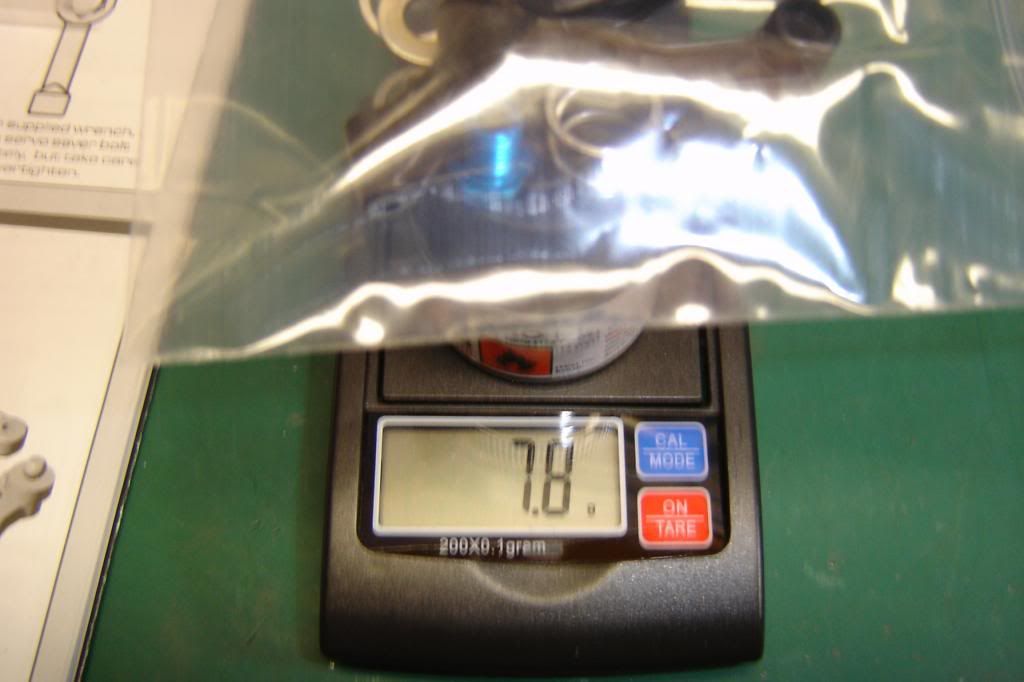
Aluminium is oddly enough lighter at 7.4g
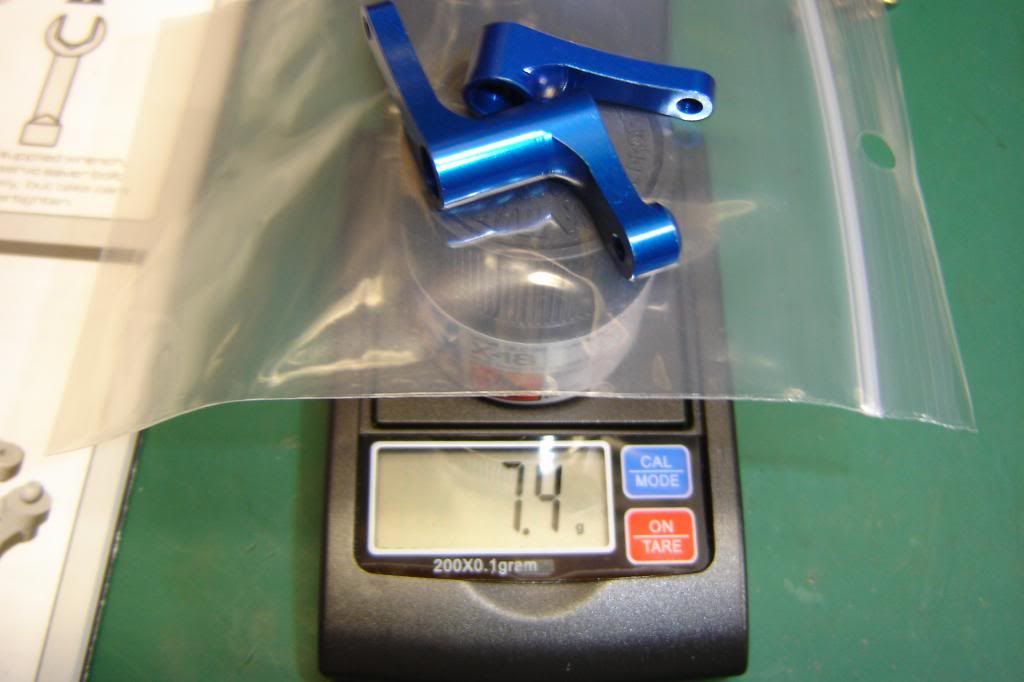
Now the front stock bulkhead is very light at 4.7g
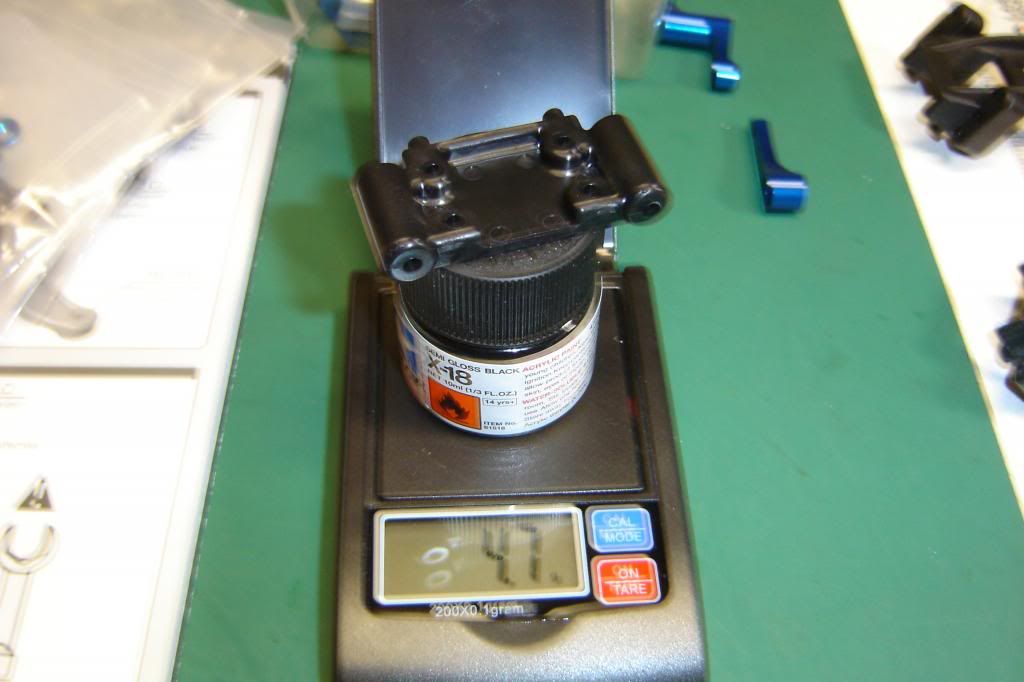
The sweet blue aluminium FT bulkhead is a heavy 9.8g but I want some of my extra weight forward and low!
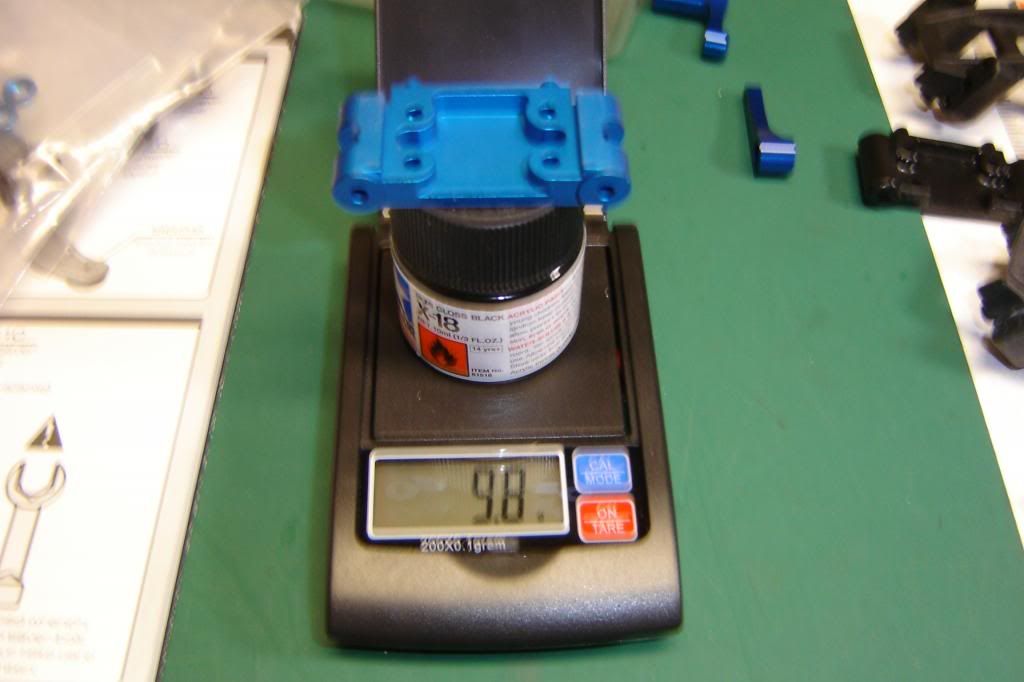

Aluminium is oddly enough lighter at 7.4g

Now the front stock bulkhead is very light at 4.7g

The sweet blue aluminium FT bulkhead is a heavy 9.8g but I want some of my extra weight forward and low!

Rod Littau
Slotcarrod's Rumpus Room: http://www.rc10talk.com/viewtopic.php?f=77&t=16113
25 Years of the RC10: http://www.rc10talk.com/viewtopic.php?f=35&t=13059
Slotcarrod's Rumpus Room: http://www.rc10talk.com/viewtopic.php?f=77&t=16113
25 Years of the RC10: http://www.rc10talk.com/viewtopic.php?f=35&t=13059
-
Panhead383
- Approved Member
- Posts: 83
- Joined: Mon May 03, 2010 11:49 pm
- Location: Maricopa, AZ
- Has thanked: 23 times
- Been thanked: 9 times
Re: RC10B4.1 Factory Team Worlds Kit by Slotcarrod
Great info! I would only suggest you not use the aluminum bulkhead. You never want weight that far forward or inline with axels.... Think of putting a case of water towards the front of a shopping cart..hard to turn. You will want to add weight in the area of the servo.
- Orange
- Approved Member
- Posts: 890
- Joined: Fri Apr 24, 2009 12:42 pm
- Location: Chandler, AZ USA
- Been thanked: 1 time
Re: RC10B4.1 Factory Team Worlds Kit by Slotcarrod
Just a note: the stock shock towers are beefier because they are thickened up areas on them to make them stronger. The B4.2 shock towers will be even heavier because there is even more plastic added to them, but that is a running change in the part number. If you take a close look at many of your parts, you will find that a lot of them are beefier.
Might be good to note in your timeline.
Might be good to note in your timeline.
- Charlie don't surf
- Approved Member
- Posts: 9284
- Joined: Tue Apr 08, 2008 2:44 pm
- Location: USA
- Has thanked: 356 times
- Been thanked: 470 times
Re: RC10B4.1 Factory Team Worlds Kit by Slotcarrod
That's because your trying to turn the wrong endPanhead383 wrote:Great info! I would only suggest you not use the aluminum bulkhead. You never want weight that far forward or inline with axels.... Think of putting a case of water towards the front of a shopping cart..hard to turn. You will want to add weight in the area of the servo.
- Lonestar
- Approved Member
- Posts: 4270
- Joined: Wed Dec 12, 2007 5:17 am
- Location: Switzerland, yannow, in Europe (or almost)
- Has thanked: 623 times
- Been thanked: 171 times
Re: RC10B4.1 Factory Team Worlds Kit by Slotcarrod
Reggie beat me to itPanhead383 wrote:Great info! I would only suggest you not use the aluminum bulkhead. You never want weight that far forward or inline with axels.... Think of putting a case of water towards the front of a shopping cart..hard to turn. You will want to add weight in the area of the servo.
AE RC10 - Made In The Eighties, Loved By The Ladies.
Blue Was Better - now, Blue Is Bankrupt.
Facebook affiliate program manager: "They go out and find the morons for me".
Life is short. Waste it wisely.
Blue Was Better - now, Blue Is Bankrupt.
Facebook affiliate program manager: "They go out and find the morons for me".
Life is short. Waste it wisely.
- slotcarrod
- Approved Member
- Posts: 4415
- Joined: Tue Nov 25, 2008 10:57 pm
- Location: Calgary Alberta Canada
- Has thanked: 1 time
- Been thanked: 45 times
Re: RC10B4.1 Factory Team Worlds Kit by Slotcarrod
Thanks for all the advice guys! I take everything into consideration!  I will be changing parts around when I get out to the rebuilt track for testing!
I will be changing parts around when I get out to the rebuilt track for testing! 
Sean, I did notice a change in the molding of the parts, but would love to know when this took place? I think the later B4 or the B4.1?
Sean, I did notice a change in the molding of the parts, but would love to know when this took place? I think the later B4 or the B4.1?
Rod Littau
Slotcarrod's Rumpus Room: http://www.rc10talk.com/viewtopic.php?f=77&t=16113
25 Years of the RC10: http://www.rc10talk.com/viewtopic.php?f=35&t=13059
Slotcarrod's Rumpus Room: http://www.rc10talk.com/viewtopic.php?f=77&t=16113
25 Years of the RC10: http://www.rc10talk.com/viewtopic.php?f=35&t=13059
- Orange
- Approved Member
- Posts: 890
- Joined: Fri Apr 24, 2009 12:42 pm
- Location: Chandler, AZ USA
- Been thanked: 1 time
-
Scott S.
- Approved Member
- Posts: 70
- Joined: Sun Apr 01, 2012 9:20 pm
- Location: Albuquerque , New Mexico
Re: RC10B4.1 Factory Team Worlds Kit by Slotcarrod
Reason for the carbon parts is not weight but they are far more rigid for use on high bite tracks. Weight is not a huge deal as we ALL add weight to the cars to make them more consistent. We have been adding weight to the car since 4 months after it came out in 03' .
* Team Associated * Reedy * LRP * Proline * Avid * Byrons Fuel * TFR *
-
slow_jun
- Approved Member
- Posts: 958
- Joined: Mon Oct 05, 2009 10:59 am
- Location: Manila/Singapore
- Been thanked: 3 times
Re: RC10B4.1 Factory Team Worlds Kit by Slotcarrod
been Eying to get one, but maybe the 4.2, but just want to ask, what would be the benefit of using the graphite parts against the composite one? is the graphite stronger?i heard that the graphite tends to break easily as compared to the composite one.the composite one tends to flex first then when it reach its breaking point, it will snap . As for the graphite, it tends to snap... dont know if this is true but would surely want to know based from experience of guys on here.
“It is more shameful to distrust our friends than to be deceived by them.”
― Confucius
― Confucius
- slotcarrod
- Approved Member
- Posts: 4415
- Joined: Tue Nov 25, 2008 10:57 pm
- Location: Calgary Alberta Canada
- Has thanked: 1 time
- Been thanked: 45 times
Re: RC10B4.1 Factory Team Worlds Kit by Slotcarrod
The pros of using Carbon are light weight and on suspension, more significantly, less unsprung weight! Used in high traction situations, quicker response! The cons would be less traction and easy to break!
The pros of composite are harder to break, flex for more traction on loose rough tracks. More forgiving to drive and not as twitchy as carbon! The cons would only be weight! But as you can see in my pictures, the weight difference in the new design arms and the older design carbon arms are not significant, .1g!
In the end it's just a tuning aid and used based on track conditions! On my local track I will probably be using the composite arms and the lighter composite top plate!
The pros of composite are harder to break, flex for more traction on loose rough tracks. More forgiving to drive and not as twitchy as carbon! The cons would only be weight! But as you can see in my pictures, the weight difference in the new design arms and the older design carbon arms are not significant, .1g!
In the end it's just a tuning aid and used based on track conditions! On my local track I will probably be using the composite arms and the lighter composite top plate!
Rod Littau
Slotcarrod's Rumpus Room: http://www.rc10talk.com/viewtopic.php?f=77&t=16113
25 Years of the RC10: http://www.rc10talk.com/viewtopic.php?f=35&t=13059
Slotcarrod's Rumpus Room: http://www.rc10talk.com/viewtopic.php?f=77&t=16113
25 Years of the RC10: http://www.rc10talk.com/viewtopic.php?f=35&t=13059
Create an account or sign in to join the discussion
You need to be a member in order to post a reply
Create an account
Not a member? register to join our community
Members can start their own topics & subscribe to topics
It’s free and only takes a minute
Sign in
-
- Similar Topics
- Replies
- Views
- Last post
-
- 4 Replies
- 1052 Views
-
Last post by jeepy2013
-
- 20 Replies
- 3837 Views
-
Last post by R6cowboy
-
- 91 Replies
- 13118 Views
-
Last post by slotcarrod
-
- 8 Replies
- 1708 Views
-
Last post by Lonestar
-
- 191 Replies
- 29481 Views
-
Last post by Mark Westerfield
-
- 35 Replies
- 5600 Views
-
Last post by Ucsdmutt
-
- 0 Replies
- 2467 Views
-
Last post by mytimac
-
- 1 Replies
- 588 Views
-
Last post by fordtransman
Who is online
Users browsing this forum: No registered users and 3 guests
